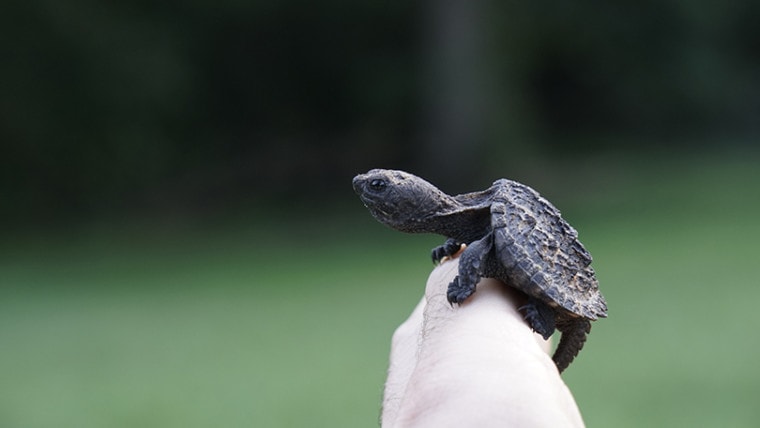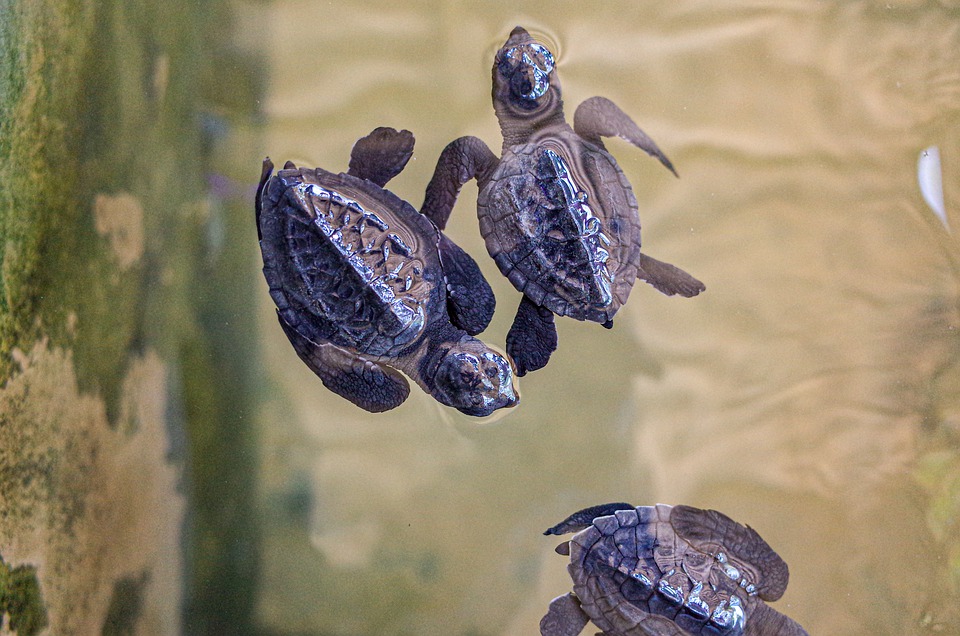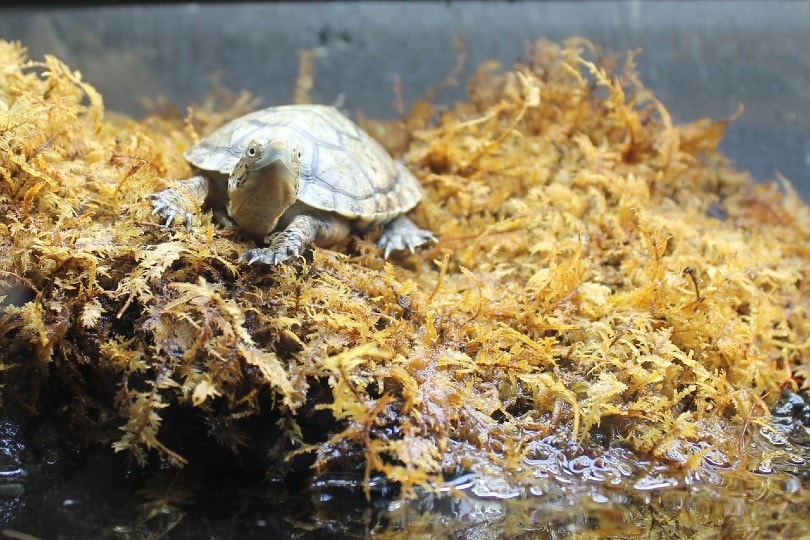
Turtles are adorable and fascinating reptiles. It’s not every day that you come across someone who carries their whole house around with them! When it comes to raising turtles, though, they have specifics that shouldn’t be overlooked. Baby turtles are especially vulnerable to problems related to poor husbandry, preventing proper, healthy development. Healthy adult turtles start off as well-cared-for baby turtles.
Here are the basics of caring for a baby turtle to give them the best start in life.
Turtle Facts
From a taxonomy point of view, turtles (of the order Testudines) comprise all 360 species of sea turtles, aquatic turtles, semi-aquatic turtles, and tortoises. There’s a great deal of confusion when it comes to turtles versus tortoises, but the easiest way to keep them straight is that most turtles are aquatic or semi-aquatic. There are exceptions to this, like the Eastern box turtle, but generally speaking, tortoises are terrestrial and turtles are aquatic. In the 1940s and into the 1950s, aquatic turtles entered the pet trade in the U.S.
The most popular and common aquatic turtle is the red eared slider (Trachemys scripta elegans). The care information provided in this article will focus primarily on this species.
Red eared slider turtles kept as pets get much larger than many people realize, often reaching 10–15 inches in length. They are exceptionally long-lived, with most reaching 20 years with proper care. It’s not out of the realm of possibility for a turtle to exceed 40 years of age.
Unless you come across a baby turtle in the wild, someone gives you one, or you breed your own turtles, it’s unlikely that you’ll accidentally have a small baby turtle come into your care. Often, the decision to adopt a turtle is a conscious choice. Animals should not be caught from the wild to be kept as pets, as this greatly disrupts ecosystems.
It is crucial that you check local laws before adopting a new turtle species. In some countries, there are laws against adopting turtles under a particular size. In the US, the FDA prohibits the sale of turtles with shells smaller than 4 inches (10 cm).

Are Baby Turtles Good Pets?
Baby turtles do not make particularly good pets, even though they’re cute as a button. Most turtles are not big on being handled, and it can stress them, leading to health problems and even aggression. Most turtles are best left alone except when you need to move them for enclosure maintenance, feeding, or healthcare. Turtles are considered babies from shortly after hatching to around 1 year of age, which is when they are considered juveniles. Breeders should be able to tell you the age of a turtle that you purchase, but pet stores may have difficulty accessing this information to give you.
Baby turtles can be difficult to care for (and in some cases illegal to own), and they can be sensitive to stress and illness. They require daily feeding, and you should check the enclosure and basking temperatures daily. Red ear sliders require an aquarium setup which also has a dedicated “dry” area which allows them to fully surface out of the water to bask or rest.
Where Can I Get a Baby Turtle?
Most big box pet stores sell turtles that are usually babies or juveniles, depending on the species. You may be able to find a baby turtle at local aquatics or pet stores, though they may be more difficult to find this way. A surefire way of acquiring a baby turtle is through breeders and online shops. Make sure you thoroughly research the breeder or store that you are purchasing from. Some sellers will not sell you a healthy baby turtle, which affects your ability to care for the turtle properly. Again, it cannot be stressed enough that you should research the laws and regulations to owning a turtle baby where you reside prior to making this decision.

How Much Does It Cost to Own a Baby Turtle?
For a baby turtle, you will likely spend a minimum of $50. If you are purchasing a unique shell pattern or species, you might spend $500 or more. When you get a baby turtle, it may be tempting to purchase a small enclosure because the turtle is so small. However, they grow rapidly in the first year of life and can quickly outgrow a small tank. If you purchase a small species of turtle, a 29-gallon tank may suffice on a temporary basis. A larger species will likely require a tank over 40 gallons. You will likely spend $40 or more on a tank for your turtle. Your turtle will also need a filter, raised basking area, heat lamp, lighting, and tank accessories, so tank setup can cost $100 or more.
Feeding a baby turtle won’t break the bank, so you can expect to spend around $30–50 monthly on feeding your baby turtle. When you first get your baby turtle, a vet checkup is strongly recommended to verify their health status. This initial visit will probably cost you $75 or more, but you will not need to take your turtle to the vet regularly throughout their life unless there is an emergency or illness.
What Kind of Home Does My Baby Turtle Need?
Tank
For a young red eared slider, you will need a watertight aquarium that is at minimum, 29 gallons. The land area of the tank should be around ⅓ of the tank, and they seem to benefit from water that is more than 12 inches (30 cm) deep. Larger turtles are a large number of juveniles and are often housed in outdoor enclosures and ponds. Even if you have a single turtle, allowing them the opportunity to spend at least part of each year (the summer months) in a secure outdoor enclosure is advised by veterinarians 1.
Substrate
For aquariums, you have the option of a bare bottom tank, pool filter sand, turtle-specific substrate, and pebbles. It’s important that any pebbles or gravel that you use are too large for your turtle to eat. For vivariums, coco coir or coconut fiber is the best choice, but you can also use a soil and sand mixture, peat moss, and turtle-safe mulch.

Light and Heat
Your turtle will need a light that provides UVB rays to maintain shell and bone health. A heat lamp will not provide UVB rays, so you’ll need a separate heat lamp and UVB light. Heat lamps are also a necessity to be used in a basking area at one end of the enclosure. Some people purchase heat lamps with day/night lighting that provides red lighting at night that doesn’t bother nocturnal turtles.
Red ear sliders require broad spectrum lighting (UVB 290-300 nm). Their tank should be maintained between 22–27 °C (72 – 81 °F). The temperature of their basking spot should be approximately 32 °C (around 90 °F), whereas nighttime temperatures should not fall below 17 °C (63 °F).
Tank Accessories
Baby turtles need access to a basking area. Red ear sliders need a surface outside the water they can access as needed for basking. These areas should be raised but still approximately 12 inches from the heat source. Other tank accessories include décor and plants. Take note that turtles may eat aquarium plants, so you may want to avoid adding a treasured plant to their aquarium.
Filter
Baby turtles in aquariums need a strong filtration system to keep their water quality high. Some filters are marketed as filters for turtle tanks. Your other option is to purchase a filter that is rated for a tank larger than the tank that your baby turtle lives in. Baby turtles are sometimes messier than adults, because they feed more frequently (therefore they poop more frequently too).
What Should I Feed My Baby Turtle?
Red ear sliders, like other aquatic turtles, are considered omnivores. However, as babies, their diet tends to be very heavily biased towards that of a carnivorous turtle. They require more protein and fat in their diet than an adult would 2. This mandates a diet high in prey, such as crickets, grasshoppers, mealworms, and waxworms.
It is crucial to note that overfeeding a baby turtle is just as detrimental to their health as underfeeding them. Red ear sliders (like many other turtles) are opportunistic feeders, and may tend to always appear hungry.
Many first-time owners tend to lean on a diet that relies heavily on commercial turtle pellets to ensure their pet is getting a good amount of baseline nutrition. This is supplemented with treats such as the aforementioned insect prey.
It is best to consult your veterinarian for a meal plan that works best for your pet as in addition to their age, many other factors play a role in their nutritional needs. The following table summarizes some of the prey choices for your pet.
| Majority of Diet | Minority of Diet |
| Slugs | Wax worms |
| Pinkies (baby mice) | Mealworms |
| Smelt | Raw lean beef |
| Crickets | Flaked or pellet turtle food |
Such a diet is often supplemented with plant leaves, aquatic plants, and a small serving of assorted salads. As turtles age into adulthood, the portion of plant-based matter should be adjusted accordingly.

How Do I Take Care of My Baby Turtle?
Feeding
Feed your baby turtle on a schedule established by your vet, and remove any uneaten food. Some people recommend placing aquatic turtles into a separate tank for meals because they can be messy and have a tendency to defecate while eating.
Handling
Handle your baby turtle as little as possible to avoid stressing them. If needed, catch them quickly and with minimal jostling, and hold them gently. Terrestrial turtles tend to be less stressed by handling than aquatic turtles. Wash your hands well immediately before and after handling. You should not pull your pet from their tell or legs, they should be picked up by placing your hands along the side of their shells.
Bathing
Aquatic baby turtles will not require bathing or shell cleaning. If they get waste or food matter on them, baby terrestrial turtles may need a quick wipe down or lukewarm water soak in a shallow dish.

Brumation
Brumation is a semi-hibernation state that turtles and other reptiles go through in cooler weather. During this time, they will eat much less and will be far less active. During this time, you’ll likely need to make temperature adjustments to allow for healthy brumation. Baby turtles should not be made to brumate and should be brought indoors in a temperature-controlled environment. Questions or concerns about brumation and baby turtles should be discussed with your veterinarian, since it varies based on age and species.
Enclosure Care
Because turtles may carry Salmonella spp. (without showing any signs of illness), the current consensus in veterinary literature is to do a full water change on a weekly basis, as this minimizes the risk of cross contamination. This is also why it isn’t recommended to house turtles with fish; not only will they consider the fish as prey, but fish cannot withstand complete water changes.

How Do I Know If My Baby Turtle Is Sick?
Shell Damage
Shell damage can happen from an injury or an illness. If you notice cracks, peeling, or soft spots on your baby turtle’s shell, your turtle’s veterinarian should take a look to help you determine the cause.
Vitamin A Deficiency
This deficiency often correlates to an imbalanced diet. Signs include lethargy, inappetence, swelling around the eyes, purulent discharge around the eyes, abscesses, and respiratory infections. Vitamin A deficiency can be remedied with an adequate diet but should be evaluated by a vet. Be prepared to take a thorough account to the vet of what your baby turtle eats in a day.
Abscesses
Abscesses are pockets of infection that can lead to systemic infections. They are caused by bacteria and can occur even with the tiniest of scratches. Turtles tend to get abscesses around their ear openings, but it’s possible for them to get abscesses almost anywhere on their body. Abscesses produce noticeably swollen areas that are often coupled with redness and may even look like a large pimple. These should be treated by a veterinarian.
Respiratory Infections
Respiratory infections are typically caused by bacteria or viruses, but they may also be secondary to a vitamin A deficiency. Signs include open-mouth breathing, nasal discharge, thickened mucoid discharge from the mouth, lethargy, and inappetence. Respiratory infections can quickly become complicated, so these clinical signs should be evaluated by your baby turtle’s vet as soon as possible.
Conclusion
Baby turtles are exceptionally cute, but they can be difficult to care for and don’t make the best pets, especially for children and people who prefer interactive pets. Your baby turtle will likely learn to associate you with food and safety, but most still prefer that you give them space and minimal handling so they don’t feel stressed. Stressed baby turtles can get sick quickly, so provide a safe, healthy environment for your baby turtle, and keep in touch with your veterinarian if you notice any problems.
Related Reads:
- How Many Babies Do Turtles Have? How Many Eggs Do They Lay?
- Why Is My Turtle Not Basking? 6 Vet-Reviewed Reasons & What to Do
Featured Image Credit: Hoth Cook, Shutterstock









